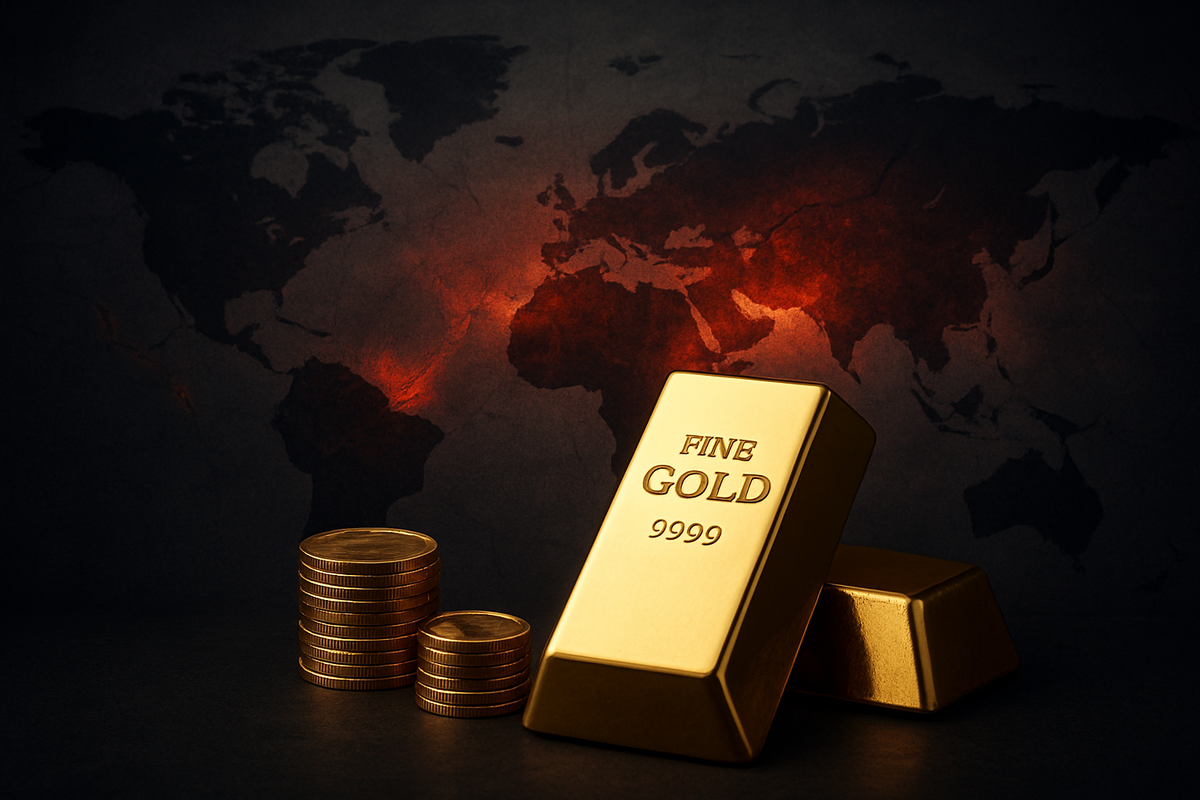
As of November 17, 2025, a complex web of escalating geopolitical tensions is driving an unprecedented surge in demand for gold, firmly cementing its status as the ultimate safe-haven asset. From persistent US-China rivalries to renewed conflicts in the Middle East and the protracted war in Eastern Europe, global instability is profoundly reshaping financial markets and compelling investors to seek refuge in the precious metal. This pervasive uncertainty has propelled gold prices to historic highs, signaling a significant shift in investor behavior towards defensive positioning and long-term risk mitigation.
The current climate of international flux, characterized by economic fragmentation and strategic competition, has underscored gold's traditional role as a reliable store of value amidst uncertainty. Investors, both institutional and individual, are increasingly allocating capital to gold as a hedge against potential economic fallout, currency debasement, and inflationary pressures. This sustained flight to quality reflects a growing apprehension across global markets, as traditional risk assets face heightened volatility in an environment fraught with unpredictable geopolitical risks.
Unpacking the Geopolitical Drivers and Market Repercussions
The current gold rally is not a singular event but rather a culmination of several interconnected geopolitical flashpoints, each contributing to a pervasive sense of global unease. The US-China trade war remains a significant overhang, with fluctuating tariffs and tech rivalries (such as export controls on cutting-edge chips) creating persistent uncertainty in the global economic landscape. While temporary truces have offered brief respites, the underlying structural competition between the two economic superpowers continues to fuel demand for gold as a protective asset against potential disruptions.
Simultaneously, the Middle East continues to be a critical flashpoint. Recent developments, including renewed military actions, ongoing conflicts involving Iran, Israel, Saudi Arabia, and Houthi forces in the Red Sea, coupled with concerns about wider U.S.-Iran confrontations, have significantly amplified regional instability. These tensions frequently disrupt vital oil supplies and trade routes, such as the Strait of Hormuz and the Suez Canal, leading to increased energy prices and inflationary pressures that further enhance gold's appeal as an inflation hedge.
In Eastern Europe, the Russia-Ukraine War continues its protracted course, with escalations like Ukraine's drone strikes deep inside Russia and Moscow's retaliatory aerial assaults. This conflict, alongside broader NATO-Russia strategic competition, generates widespread uncertainty, compelling investors to seek safe-haven assets. While hopes for ceasefires occasionally temper gold's rally, any failure to achieve lasting peace quickly reignites safe-haven buying. Furthermore, broader global policy uncertainty, including unpredictable economic policies, concerns over fiscal sustainability, and shifting geopolitical alliances, significantly contributes to gold demand. The 2022 sanctions on Russian central bank reserves served as a "watershed moment," accelerating gold accumulation among central banks, particularly in emerging markets, seeking to diversify away from traditional reserve currencies like the US dollar to hedge against sanctions risks and maintain monetary sovereignty.
These factors have had immediate and dramatic implications for financial markets. Gold prices have experienced a significant surge in 2025, reaching new record highs. Spot gold prices jumped above $4,200 an ounce in October 2025, hitting an all-time high of $4,218, after being around $3,028 per ounce in June 2025 and $3,500 per ounce in April. By mid-November 2025, gold has maintained robust support well above the $4,000 threshold, exhibiting intraday swings but demonstrating underlying structural strength. Forecasts remain bullish, with some experts predicting averages of $3,675/oz by Q4 2025 and rising towards $4,000-$5,000/oz by 2026. Gold has been 2025's strongest major asset, posting a year-to-date return of approximately 36-55% by mid-November. Conversely, equity markets have experienced significant volatility, with major indices shedding gains during periods of heightened trade disputes and international military conflicts. The US dollar has seen mixed movements, while defensive currencies like the Swiss Franc (CHF) have appreciated. Importantly, gold has dramatically outperformed cryptocurrencies like Bitcoin (BTC) in 2025, with Bitcoin experiencing severe pullbacks and heavy ETF outflows, becoming the worst-performing major asset by mid-November, down more than 26% since its October peak. This indicates that in 2025's volatile environment, investors have favored assets with low volatility and high liquidity, with Bitcoin behaving more as a high-beta macro asset rather than a reliable safe haven.
Companies Navigating the Golden Tide
The robust demand for gold in a geopolitically charged environment creates clear winners and losers across various sectors. Gold mining companies, particularly those with significant reserves and efficient operations, stand to benefit immensely from elevated gold prices. Major players such as Barrick Gold Corp. (NYSE: GOLD) and Newmont Corporation (NYSE: NEM) are likely to see improved profitability and cash flows. Higher gold prices directly translate to increased revenue per ounce extracted, potentially leading to stronger earnings reports and enhanced shareholder returns. Junior miners and exploration companies might also attract increased investment as the hunt for new gold deposits intensifies.
Beyond direct mining, companies involved in gold-backed exchange-traded funds (ETFs) and precious metals trading platforms are also experiencing a boom. Providers of physically backed gold ETFs, such as the SPDR Gold Shares (NYSEARCA: GLD) and the iShares Gold Trust (NYSEARCA: IAU), are seeing significant inflows as investors seek easily accessible ways to gain exposure to gold without direct physical ownership. Financial institutions with strong precious metals trading desks are also poised to capitalize on increased trading volumes and market volatility.
Conversely, companies heavily reliant on global trade and stable international relations may face headwinds. Multinationals with extensive supply chains that traverse regions impacted by geopolitical conflicts or trade disputes could experience disruptions, increased operational costs, and reduced profitability. For instance, manufacturing companies with significant exposure to US-China trade tensions, or those with operations in volatile regions of the Middle East, might struggle with tariffs, logistical challenges, and diminished consumer demand. Technology companies, particularly those involved in semiconductor manufacturing, could be vulnerable to export controls and restrictions stemming from strategic rivalries. While not direct "losers" in the same vein as those losing market share, companies that rely on predictable global economic conditions and open trade are finding it increasingly challenging to navigate the current landscape, potentially impacting their growth prospects and investor sentiment.
Wider Significance: A New Era of Financial Geopolitics
The current surge in safe-haven demand for gold signifies more than just a temporary market reaction; it points to a deeper, more structural shift in the global financial landscape. This event fits squarely into broader industry trends of de-dollarization and increased diversification by central banks. The 2022 sanctions on Russian central bank reserves served as a stark reminder of the risks associated with holding large reserves in a single currency, accelerating a trend where central banks, particularly in emerging markets, are accumulating gold at an unprecedented pace. This strategic move aims to hedge against sanctions risks, maintain monetary sovereignty, and diversify away from traditional reserve currencies like the US dollar. The persistent high demand from central banks, forecasted to be around 900 tonnes in 2025, underscores a long-term shift in global reserve management.
The ripple effects extend beyond direct gold markets. Heightened geopolitical risks contribute to increased volatility across all asset classes, pushing investors towards defensive strategies. This environment can lead to capital reallocation from riskier assets like equities and certain cryptocurrencies (as seen with Bitcoin's underperformance in 2025) towards perceived safer havens. The ongoing inflationary pressures, fueled by supply chain disruptions from conflicts and deglobalization trends, further enhance gold's appeal as an inflation hedge, creating compounding demand from both safe-haven and inflation-protection motivations.
Regulatory and policy implications are also significant. Governments and international bodies may increasingly consider the implications of geopolitical instability on financial markets when formulating economic policies. There could be renewed discussions around international financial architecture, reserve currency roles, and the stability of global trade mechanisms. Historically, periods of intense geopolitical strife, such as the Cold War era or the oil crises of the 1970s, have consistently seen gold perform strongly as a safe haven. The current environment, with its multi-front geopolitical challenges, echoes these precedents, suggesting that gold's role as a counter-cyclical asset during times of uncertainty remains as relevant as ever, perhaps even more so given the interconnectedness of today's global economy. The structural nature of current geopolitical tensions implies that this is not merely a cyclical phenomenon but rather a new baseline for risk assessment in global portfolios.
What Comes Next: Navigating the Golden Horizon
Looking ahead, the short-term and long-term possibilities for gold and the broader market are heavily intertwined with the trajectory of global geopolitical events. In the short term, any escalation in existing conflicts—be it in the Middle East, Eastern Europe, or further deterioration in US-China relations—would likely trigger further spikes in gold prices. Conversely, any significant de-escalation or diplomatic breakthroughs, however unlikely they may seem currently, could lead to temporary pullbacks in gold, as risk appetite tentatively returns to the market. However, given the entrenched nature of many current geopolitical issues, significant and sustained de-escalation appears challenging.
For investors, this environment presents both market opportunities and challenges. The sustained demand for gold suggests that it will likely remain a core component of diversified portfolios, offering a hedge against ongoing volatility and inflation. Opportunities may emerge in gold mining equities that offer strong fundamentals and dividend yields, as well as in precious metals streaming and royalty companies that benefit from higher prices without direct operational risks. Challenges include managing the volatility inherent in a risk-off environment and identifying genuinely resilient companies amidst broader market uncertainty. Companies will need to adapt strategically, perhaps by diversifying supply chains, strengthening local operations, and hedging against currency fluctuations.
Several potential scenarios and outcomes could unfold. A "high-tension, contained conflict" scenario would likely see gold maintain its elevated levels, with occasional surges during periods of heightened news. A more severe "global fragmentation" scenario, involving widespread trade wars and a breakdown of international cooperation, could push gold significantly higher, potentially towards the $5,000/oz mark or beyond, as investors entirely abandon traditional risk assets. Conversely, a "diplomatic breakthrough" scenario, while less probable in the immediate future, could lead to a re-evaluation of gold's premium, though its role as a long-term store of value would likely remain intact given the underlying structural shifts in central bank behavior. The trend of central bank gold accumulation is expected to continue regardless of short-term price movements, providing a strong floor for gold demand.
Comprehensive Wrap-Up: Gold's Enduring Role in a Turbulent World
In summary, the current global landscape, marked by persistent geopolitical tensions across multiple regions, economic fragmentation, and strategic rivalries, has unequivocally cemented gold's role as the paramount safe-haven asset. Key takeaways include the unprecedented surge in gold prices to over $4,000/oz, driven by the US-China trade war, Middle East instability, the Russia-Ukraine conflict, and a broader trend of central bank diversification. This has led to a significant shift in investor behavior towards defensive positioning and increased portfolio allocation to gold, outperforming other perceived safe havens like Bitcoin in 2025.
Moving forward, the market is poised for continued volatility, with geopolitical developments serving as primary catalysts. Gold is expected to maintain its robust support, with forecasts pointing to sustained high prices well into 2026. Companies in the gold mining sector (e.g., Barrick Gold Corp., Newmont Corporation) and providers of gold-backed ETFs (e.g., SPDR Gold Shares, iShares Gold Trust) are positioned to benefit, while companies heavily reliant on stable global trade may face ongoing challenges.
The lasting impact of this period will likely be a fundamental re-evaluation of risk in global portfolios and a reinforced understanding of gold's intrinsic value in times of uncertainty. Investors should continue to watch for any significant shifts in geopolitical dynamics, central bank policy statements regarding reserves, and macroeconomic indicators such as inflation rates. The current environment underscores that gold is not just a speculative asset but a critical component for wealth preservation and portfolio stability in an increasingly unpredictable world.
This content is intended for informational purposes only and is not financial advice






